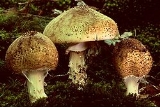
Lepiota aspera
Encyclopedia
Lepiota aspera; sometimes known commonly as the Freckled Dapperling, is a large brownish; white gilled mushroom, with a warty or scaly cap. It lives in woodland, or on bark chips in parks, and gardens.
& Fries
), the Freckled Dapperling has been back and forth through many taxonomical name changes. For a time; it was placed with the so called spiny Lepiota
species into a separate sub-genus called Echinoderma, and was also placed into Cystolepiota. However; the most recent and widely accepted binomial name is Lepiota aspera (Pers.
) Quel.
The genus name Lepiota
coming from the Greek, and meaning 'scale', which probably refers to the cap surface.
is oval at first; becoming convex, or campanulate with age. Uniform reddish/brown, or brown at the centre; breaking up into erect scales, on a paler ground, and up to 10cms in diameter. The stem
is paler; around 10cms in length, and has sparse brown scales below the ring
. The ring itself is large and cottony; sometimes adhering to the cap perimeter, and often taking brownish scales from there, which are seen at it’s edge. The gills are free; crowded, and white, with the spore print being white also. The flesh is white, and is said to smell of rubber; earth balls, or Lepiota cristata.
woodland, or in parks and gardens where 'wood chip' mulch has been used. It has been recorded in most northern temperate zones; England; Europe, and North Africa.
Taxonomy
Noted by two of the most eminent nineteenth century mycologists (PersoonChristian Hendrik Persoon
Christiaan Hendrik Persoon was a mycologist who made additions to Linnaeus' mushroom taxonomy.-Early life:...
& Fries
Elias Magnus Fries
-External links:*, Authors of fungal names, Mushroom, the Journal of Wild Mushrooming.*...
), the Freckled Dapperling has been back and forth through many taxonomical name changes. For a time; it was placed with the so called spiny Lepiota
Lepiota
Lepiota is a genus of gilled mushrooms in the family Agaricaceae. All Lepiota species are ground-dwelling saprotrophs with a preference for rich, calcareous soils. Basidiocarps are agaricoid with whitish spores, typically with scaly caps and a ring on the stem. Around 400 species of Lepiota are...
species into a separate sub-genus called Echinoderma, and was also placed into Cystolepiota. However; the most recent and widely accepted binomial name is Lepiota aspera (Pers.
Christian Hendrik Persoon
Christiaan Hendrik Persoon was a mycologist who made additions to Linnaeus' mushroom taxonomy.-Early life:...
) Quel.
Lucien Quélet
thumb|Lucien QuéletLucien Quélet was a French mycologist and naturalist who discovered several species and was the founder of the Société mycologique de France, a society devoted to mycological studies....
The genus name Lepiota
Lepiota
Lepiota is a genus of gilled mushrooms in the family Agaricaceae. All Lepiota species are ground-dwelling saprotrophs with a preference for rich, calcareous soils. Basidiocarps are agaricoid with whitish spores, typically with scaly caps and a ring on the stem. Around 400 species of Lepiota are...
coming from the Greek, and meaning 'scale', which probably refers to the cap surface.
Description
The capPileus (mycology)
The pileus is the technical name for the cap, or cap-like part, of a basidiocarp or ascocarp that supports a spore-bearing surface, the hymenium. The hymenium may consist of lamellae, tubes, or teeth, on the underside of the pileus...
is oval at first; becoming convex, or campanulate with age. Uniform reddish/brown, or brown at the centre; breaking up into erect scales, on a paler ground, and up to 10cms in diameter. The stem
Stipe (mycology)
thumb|150px|right|Diagram of a [[basidiomycete]] stipe with an [[annulus |annulus]] and [[volva |volva]]In mycology a stipe refers to the stem or stalk-like feature supporting the cap of a mushroom. Like all tissues of the mushroom other than the hymenium, the stipe is composed of sterile hyphal...
is paler; around 10cms in length, and has sparse brown scales below the ring
Annulus (mycology)
An annulus is the ring like structure sometimes found on the stipe of some species of mushrooms. The annulus represents the remaining part of the partial veil, after it has ruptured to expose the gills or other spore-producing surface. An annulus may be thick and membranous, or it may be cobweb-like...
. The ring itself is large and cottony; sometimes adhering to the cap perimeter, and often taking brownish scales from there, which are seen at it’s edge. The gills are free; crowded, and white, with the spore print being white also. The flesh is white, and is said to smell of rubber; earth balls, or Lepiota cristata.
Similar species
Check Lepiota; Macrolepiota, and Amanita species.Distribution and habitat
Lepiota aspera appears during autumn; in deciduousDeciduous
Deciduous means "falling off at maturity" or "tending to fall off", and is typically used in reference to trees or shrubs that lose their leaves seasonally, and to the shedding of other plant structures such as petals after flowering or fruit when ripe...
woodland, or in parks and gardens where 'wood chip' mulch has been used. It has been recorded in most northern temperate zones; England; Europe, and North Africa.

